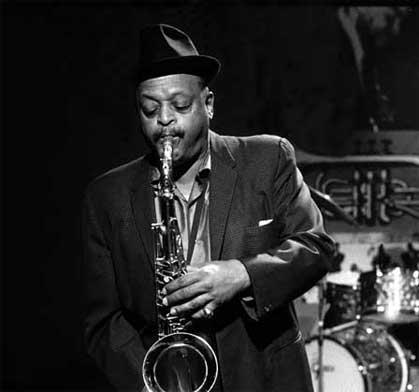Ben Webster (Benjamin Francis Webster)

Ben Webster learned to play piano and violin at an early age before taking up the saxophone, although he did return to the piano from time to time, even recording on the instrument occasionally. Once Budd Johnson showed him some basics on the saxophone, Webster began to play that instrument in the Young Family Band (which at the time included Lester Young). Kansas City at this point was a melting pot from which emerged some of the biggest names in 1930s jazz. Webster joined Bennie Moten’s band in 1932, a grouping which also included Count Basie, Oran “Hot Lips” Page and Walter Page. This era was recreated in Robert Altman’s film Kansas City. Webster spent time with quite a few orchestras in the 1930s, including Andy Kirk, the Fletcher Henderson Orchestra in 1934, then Benny Carter, Willie Bryant, Cab Calloway, and the short-lived Teddy Wilson big band. Ben Webster played with Duke Ellington’s orchestra for the first time in 1935, and by 1940 was performing with it full-time as the band’s first major tenor soloist. He credited Johnny Hodges, Ellington’s alto soloist, as a major influence on his playing. During the next three years, he played on many recordings, including “Cotton Tail” and “All Too Soon”; his contributions (together with that of bassist Jimmy Blanton) were so important that Ellington’s orchestra during that period is known as the Blanton–Webster band. Webster left the band in 1943 after an angry altercation during which he allegedly cut up one of Ellington’s suits.[citation needed]. In an interview with the Newark Star-Ledger in 2003, trumpeter Clark Terry claimed that Webster left Ellington because he slapped Duke, after which he was given his two-weeks notice.
After leaving Ellington in 1943, Ben Webster worked on 52nd Street in New York City, where he recorded frequently as both a leader and a sideman, During this time he had short periods with Raymond Scott, John Kirby, Bill DeArango, and Sid Catlett, as well as with Jay McShann’s band, which also featured blues shouter Jimmy Witherspoon. For a few months in 1948, he returned briefly to Ellington’s orchestra. In 1953, he recorded King of the Tenors with pianist Oscar Peterson, who would be an important collaborator with Webster throughout the decade in his recordings for the various labels of Norman Granz. Along with Peterson, trumpeter Harry ‘Sweets’ Edison and others, he was touring and recording with Granz’s Jazz at the Philharmonic package. In 1956, he recorded a classic set with pianist Art Tatum, supported by bassist Red Callender and drummer Bill Douglass. Coleman Hawkins Encounters Ben Webster with fellow tenor saxophonist Coleman Hawkins was recorded on December 16, 1957, along with Peterson, Herb Ellis (guitar), Ray Brown (bass), and Alvin Stoller (drums). The Hawkins and Webster recording is a jazz classic, the coming together of two giants of the tenor saxophone, who had first met back in Kansas City. In the late 1950s, he formed a quintet with Gerry Mulligan and played frequently at a Los Angeles club called Renaissance. It was there that the Webster-Mulligan group backed up blues singer Jimmy Witherspoon on an album recorded live.
Webster generally worked steadily, but in 1965 he moved permanently to Europe, working with other American jazz musicians based there as well as local musicians. He played when he pleased during his last decade. He lived in London for one year, followed by four years in Amsterdam and made his last home in Copenhagen in 1969. Webster appeared as a sax player in a low-rent cabaret club in the 1970 Danish blue film titled Quiet Days in Clichy. In 1971, Webster reunited with Duke Ellington and his orchestra for a couple of shows at the Tivoli Gardens in Copenhagen; in addition, he also recorded “live” in France with Earl Hines. He also recorded or performed with Buck Clayton, Bill Coleman and Teddy Wilson. Ben Webster suffered a cerebral hemorrhage in Amsterdam in September 1973, following a performance at the Twee Spieghels in Leiden, and died on 20 September. His body was cremated in Copenhagen and his ashes were buried in the Assistens Cemetery in the Nørrebro section of the city.
Born
- March, 27, 1909
- USA
- Kansas City, Missouri
Died
- September, 20, 1973
- Amsterdam, Netherlands
Cause of Death
- cerebral hemorrhage



